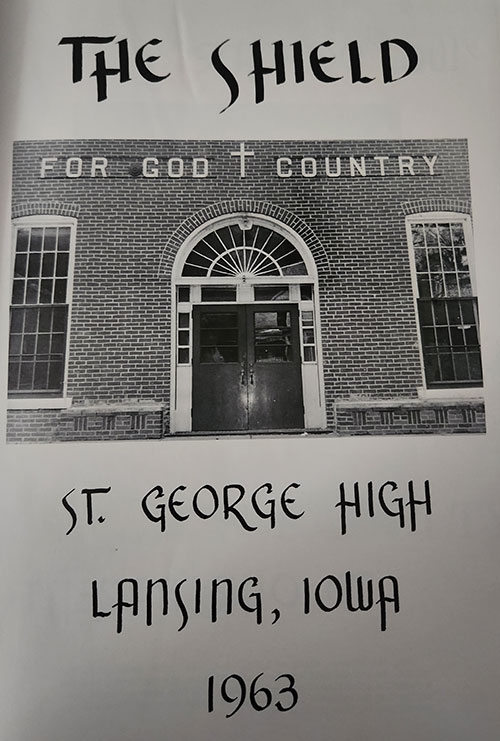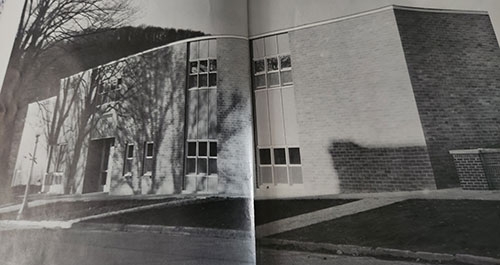You are here
Home ›Alumni, former staff will observe 50th anniversary of the closing of St. George High School with All-School Reunion this Sunday

A page in time ... The image above shows a page from the 1963 publication of “The Shield,” the annual yearbook of St. George High School. The former parochial school that served students from not only the Allamakee County area but also from across the river in Wisconsin opened in 1957 and graduated its final class in the spring of 1973. Submitted image.

Continues to be used as a school facility ... The former St. George High School building pictured above for a page in the school yearbook was constructed in 1965 to accommodate the growing needs of the school. The building still remains at its Main Street location in Lansing, just west of Immaculate Conception Catholic Church, and has been used by the Eastern Allamakee Community School District as a middle school facility and, most recently, the school district’s Kee Connect facility. Submitted photo.
by Susan Cantine-Maxson
This year marks the 50th anniversary of the closing of St. George High School in Lansing. Alumni of the former high school have been organizing a reunion of all its former students that is scheduled for this Sunday, October 15. Further details of that reunion event appear in a shaded box accompanying this article elsewhere in this week’s edition of The Standard.
HISTORICAL BACKGROUND
According to information available at www.holyfamilyofthebluffs.org, the first parochial school associated with Immaculate Conception Parish in Lansing began in 1874. In the early 1900s, a new school was built and the parish purchased the brewery next to the church and eventually converted it into a school as well. The first class graduated from Immaculate Conception High School in 1914.
When the district expanded into an inter-parish parochial school in 1957, the name St. George High School was adopted. Students attended from De Soto, Ferryville, Genoa, Stoddard and Victory in Wisconsin, in addition to residents of Harpers Ferry, Lansing, New Albin and the Paint Rock and Wexford parishes. The school year began with the enrollment of 160 students in first through 12th grades. Classes were primarily taught by nuns and priests. Some students attending from a distance boarded with the nuns at the convent.
By 1964, a new building was needed for the high school. The new building (located west of the Immaculate Conception Church and currently housing the Kee Connect facility for the Eastern Allamakee Community School District) was occupied in 1965. At one point, approximately 200 students attended the high school.
The Class of 1973 had 36 graduates as the final class to receive diplomas from St. George High School. One hundred and twelve students remained in the 9th, 10th and 11th grades. Most of these students dispersed to their local public school districts to finish their education after the school closed.
Financial difficulties, the needs of the public school system and the shortage of personnel forced the school to close in 1973. The rising costs of transportation added to the financial burden since parochial students could not ride the public school buses at the time, so the parochial school had its own school bus.
In addition, a shortage of nuns and priests meant that the district needed to hire more lay teachers than it could afford. Plus, with the new consolidation of the Eastern Allamakee Community School District, the public schools needed students to become a district and not be forced to join with even more towns. The building west of the church was sold to the Eastern Allamakee Community School District to be used as a middle school.
ALUMNI MEMORIES
When a group of alumni gather, stories of misdeeds, complaints and mischief may often abound, but when four alumni from St. George recently gathered to reminisce in anticipation of the 50th year reunion of the closing of St. George High School in Lansing, the stories centered on dedication, excellence and pride. Marlene Moore Imhoff Duffy (1968), Bill Burke (1960), Don Moore (1969) and Mary Palmborg Anderson (1965) gathered to reflect on their years and connections to St. George.
Duffy related, “I sailed through college because so much of the curriculum was material I had already covered in classes at St. George.” All concurred that classes such as Great Books and other college preparatory classes taught them to study hard and be accountable.
Burke added, “We had to be accountable because if we got into trouble at school, we got into trouble at home. Parents were footing the bill, so we were expected to do the work and do our best. Learning that discipline prepared us for college and life.”
Palmborg said, “I remember Father Condon saying that a lot of the success of the school was due to the dedication of the nuns.”
Burke shared, “Plus all the teachers, especially the nuns and priests, were dedicated to our education. They had high expectations all the time, both in school and in activities. Some of the nuns and priests had doctorates.”
Many teachers were praised but some names came up consistently. Moore stated, “Father Levenhagen was Dean of Discipline. He was very strict but could have fun in the classroom. His Mass was always 24 minutes long. He always said it was important to get right to the point.”
Palmborg remembered Sister Thomasette, who taught chemistry and physics, “as a very smart person with a personality of few words, but students didn’t want to get ‘the look’.”
Duffy fondly recalled Dr. Virginia Riser, one of the lay teachers, as a person who inspired her. “She was dedicated to preparing her students for the next steps in life,” Duffy reflected. “She had grown up in the area and then came back to teach two years at the local school and two years in the parochial school to give back to the community that had supported her.”
Palmborg remembered she taught Great Books, which covered “all the books we should read before we got to college.”
Burke explained that Wayne Kreitzer, a teacher who will speak at this Sunday’s reunion, was a great history teacher and esteemed coach.
BOOKBAGS, UNIFORMS & UNITY
When the group began discussing memories, all agreed that uniforms and book bags stood out. All students were expected to wear uniforms so there was no deciding what to wear every day. The girls wore white blouses and grey wool skirts. No jeans were allowed for the boys. Burke said, “It made everyone equal. No one could show up with a fancy outfit, but I think it added to our unity as a group.”
Moore added, “Lansing was mostly Irish Catholic and when the other parishes came in there were other ethnic groups represented such as the Italian Catholic from Genoa. The uniforms made more unity.”
Duffy added, “Plus, I think it added to the school spirit.”
Moore recalled the mandatory book bags. Palmborg added, “These were not book bags like today’s students have. It was like a suitcase that we had to carry all our books in. We didn’t have any lockers, so our books came with us.”
Moore recalled, “We had outstanding teams, plus choir and speech and drama. P.E. and basketball games were played in what is now TJ Hunter’s Banquet Hall. Teams ran up and down Mt. Hosmer for training. There was an activity bus which went to New Albin, but the parochial kids couldn’t ride it; kids either got a ride with family or friends or had to hitchhike. There was a Catholic bus, but if a student was in activities, they had to find their own ride home. One good thing was that if we had two extra minutes before the bus picked us up at school, we could run over to the A&W Root Beer stand and get a treat before we got on the bus.
“We didn’t play football or girls sports but we had other sports that were very successful. We were always very competitive. The 1973 basketball team was 47-0. Baseball was also excellent. The public schools really benefited from the St. George students joining their teams after the school closed.”
Duffy laughed, “I remember starting pep meetings with the cheer ‘Mary, Queen of Victory, Pray for Us’. You don’t hear that too often anymore! The gym was always packed with fans. The school song ‘Hurrah for the Knights of St. George’ was sung to the tune of ‘Stars and Stripes Forever’. We did have intramural sports for girls, but it wasn’t uncommon to not have many girls sports then.
“St. George is where I got my start in speech and drama. The plays were at (the current) TJ Banquet Hall as well. People still talk about the production of ‘The Sound of Music’ that St. George did one year. We were a very active high school with lots of involvement in extra-curricular activities.”
Palmborg stated, “My sister, Gail, was one of the people who helped come up with the names of the teams and publications. It all tied to St. George. The sports teams were the Knights; the junior varsity were the Squires; and the 9th graders were the Pages. The yearbook was the Shield, and the newspaper was the Lance. Another thing different from public school was that we had religion classes once a day and mass once a week; we often had prayers to open class. Religion classes often centered on life choices and values, current events and facing what was ahead of us. They helped center us as we entered life on our own.”
LASTING IMPACT
The 1973 annual concludes with pages entitled “1973 - A year of Decisions, Then…Appreciation, Gratitude and New Vision.” Father Condon, the school’s principal, presented a homily during a special celebration in April. He stated, “My wish and my prayer is that with the closing of the school there will be unity…The Spirit of St. George will live on…” The annual concludes, “The seed of unity has been planted. Let us break forth as a sign of this gift of unity given by the Father.”
Although St. George High School lasted only 15 years, the impact of the education that students received will last for generations. Duffy said that reunions are always well attended. “One year we had almost 400 people come,” she said.
Fifty years after the last class graduated, the St. George High School Facebook page has almost 700 followers. The mission of the school was to provide a Catholic education and academic quality for St. George students. As evidenced by the alumni’s memories, gratitude and pride, it achieved that mission.

